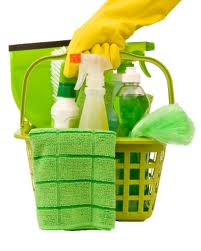 Green cleaning products are the rage, with many people looking to be friendly for the environment and healthy, however while many green products claim to be great for the environment or natural, how can yoube sure of what you are buying? What does 100% natural products mean? We'll try to help you sort through it all to decide which cleaning products you should be buying if you're looking to be green.Check for full disclosure of ingredients.Ingredient lists on cleaning supplies are not quite the same as ingredients lists on food labels. On a food label, if wheat is first and cinnamon is last, we know that there is more wheat in the product than cinnamon. Ingredients on cleaning supply labels are not listed in order of how much of the ingredient is included. It's important to keep in mind that there are no requirements for manufacturers to even list ingredients for cleaning supplies unless they contain disinfectants or items that are known to be hazardous. Look for manufacturers that list their ingredients either on the label or on their websites. Know about risky ingredients.Learn about the common ingredients in today's cleaners and which ones can be associated with health risks. By knowing which ingredients are hazardous, you'll be able to make a good choice as to which cleaner to choose. Check out the National Institute of Health to find the necessary information about which household cleaners contain which ingredients. Check the cleaner's environmental claims.Catch-phrases like "environmentally friendly", "environmentally safe", and "biodegradeable" are keywords that all sound great but you need to be carefully of what you're purchasing. Something that is made from 100% plant based ingredients is better than a cleaner that claims to be made from just natural ingredients. Make sure to investigate the products ingredient list and don't be afriad to contact the company and ask questionns.
 The EPA estimates that the majority of Americans spend approximately 90% of their time year round indoors, but that indoor air quality can be two to five times more polluted than outdoor air. "Indoor air quality can be worse than outdoor air quality in almost every case,” says William J. Calhoun, MD, professor of medicine and vice chair of the department of medicine at the University of Texas Medical Branch in Galveston.
The single most effective way to ensure pure air in the home is to keep the toxic out - so reduce or eliminate products that cause air pollution, including cigarette smoke, excess moisture and chemicals.
The second most important method to help with purifying your air is with proper ventilation so that you can pull dangerous pollutants out of the house. Make sure the vent fans in your kitchen, bathroom, and laundry room are working properly; if you don't have any, think about installing them. You can also increase air exchange by putting in an attic fan to suck stale air out and pull fresh outside air in, or investing in an energy recovery ventilator (ERV), a device that uses ducts to distribute fresh air throughout the house.
You may want to think about keeping plants that are natural air purifiers. This list (see below) of plants helps to remove your home of the following three major household toxins; benzene, formaldehyde, and trichloroethylene.- Aloe Vera
- Areca Palm
- Baby Rubber Plant
- Bamboo Palm or Reed Palm
- Boton Fern
- English Ivy
- Ficus alii
- Gerber Daisy
Portable air cleaners with HEPA filters are another option to use for individual rooms. In the end though, even with all the air-cleaning technology and the use of air-purifying plants, there's only so much that these things can do to help you breath easy. It's important to keep a clean home and use green products when possible to reduce the toxins that are floating around and make these different purifiers more effective.
 Good news to any of you that have gone through the pains of trying to clean a burnt pan. The solution that I'll be sharing today will half the scrubbing time while still allowing you to get a super clean pan. The best part is that the solution is chemical free and cheap! What You'll Need:- 1 cup of vinegar
- 2 tablespoons of baking soda
- A scourer
Instructions- Fill the bottom of the pan with a layer of water and then add a cup of vinegar.
- Bring the pan to the boil.
- Remove from heat, add the baking soda and watch the fizz!
- Empty the pan and scour as normal, if necessary add an extra bit of dry baking soda.
Your pan should be looking like new now. While you can clean the pan with just baking soda, water and scour, following the above instructions makes it much quicker and easier to clean your pan!
 Neuroscientists say humans can distinguish 10,000 scents, though we don’t have names for a lot of them.
Our sense of smell has the ability to alert us to potential dangers: harmful molds, spoiled food, rotten garbage, and decaying products. Many people try to use a variety of sprays, plug-ins, stick-ons, scented candles, and other products to try and make these odors. The problem with this strategy is that there are people who suffer allergic reactions to these products. In addition, many of these air fresheners contain potentially harmful toxins.
The good thing is that you can use natural products that you already most likely have in your home to help with removing these foul odors from your home.
Try to determine what the odor is from -- throw out old food, take out the garbage, run the garbage disposal, clean smelly shoes and dog beds, change the cat box
• Open all the windows
• Soak a cotton ball in clove oil, lemon extract, peppermint or vanilla extract; place it in a plastic bag or container with holes, and place in the smelly room
• Boil lemon or orange peels in water, and let stand
• Leave a bowl of white vinegar in the room
• Run orange or lemon peels through the garbage disposal
• Boil cinnamon sticks
• Put drops of vanilla or essential oil on light bulbs
• Unpleasant odors can be removed with baking soda. Place it where necessary in an open can or bowl.
• Closets can be kept mositure and odor free with sidewalk chalk. The chalk can be kept in a smelly pair of shoes, on the floor, on the shelf, or in a hanging net bag.
• Give a fresh smell to a small item by placing it into a plastic bag for several days with a dryer sheet.
If you have any of your own tips, I would love to hear them. Please leave a comment below!
 Use of chemicals when cleaning is a concern of parents of children of all ages. This is also a concern for those who are caring for elderly patients or family members, as well as those who have allergies. And with the "green" movement growing in popularity, more and more people are looking for ways to keep chemicals out of their homes and use non-toxic methods for cleaning. Use of homemade products eliminates this concern, but there is a lot of skepticism surrounding whether or not these products work as well as their commercial counterparts. Let me say, there's no need to worry. Homemade cleaners work as well, if not better, than commercial products and their way cheaper too. Just check out this blog post that discuss the effectiveness of homemade cleaners. Baking SodaEven though we generally think of baking soda as a way of keeping our refrigerators and freezers from getting smelly or as an ingredient for our favorite recipes, it works great as a cleaner in many areas of the home. Adding baking soda anywhere that needs to be deodorized, not just in the refrigerator or freezer, helps eliminate even the toughest odors. This includes trashcans, in sneakers, and in kitty litter. Baking soda works as well as cleansers, but it is not as abrasive. You can also add baking soda to the laundry. Many chemical based cleaners add baking soda to their product formulas, but many households have found using baking soda without the chemicals works just as well. Lemon
Lemons are not just for drinks and recipes! Did you know that, when you cut a lemon in half and rub it on your shower fixtures, it gets rid of hard water stains? Lemon juice is also notorious for ridding homes of soap scum in kitchens and bathrooms, as well as for shining copper and brass. When lemon juice is mixed with baking soda to form a paste, it is just as effective as using industrial strength bleach. Lemon juice can also be mixed with a small amount of olive oil in order to polish wooden furniture pieces. Vinegar This is, by far, the most popular natural cleaning substances next to using baking soda. Because it is so versatile and can be used in so many rooms throughout the house, vinegar mixed with water is found in spray bottles under the sinks of many non-toxic homes. In order to get the solution so it works well, mix equal parts of water and vinegar. You can clean just about any surface using vinegar including windows, countertops, appliances, bathtubs, sinks, and toilet bowls. Vinegar can also be used in the washing machine because, when clothes are transferred to the dryer or hung out on the line, it acts as a fabric softener. Some people also add vinegar to their homemade laundry detergent to ensure all the soap rinses from their fabrics.
|





 RSS Feed
RSS Feed